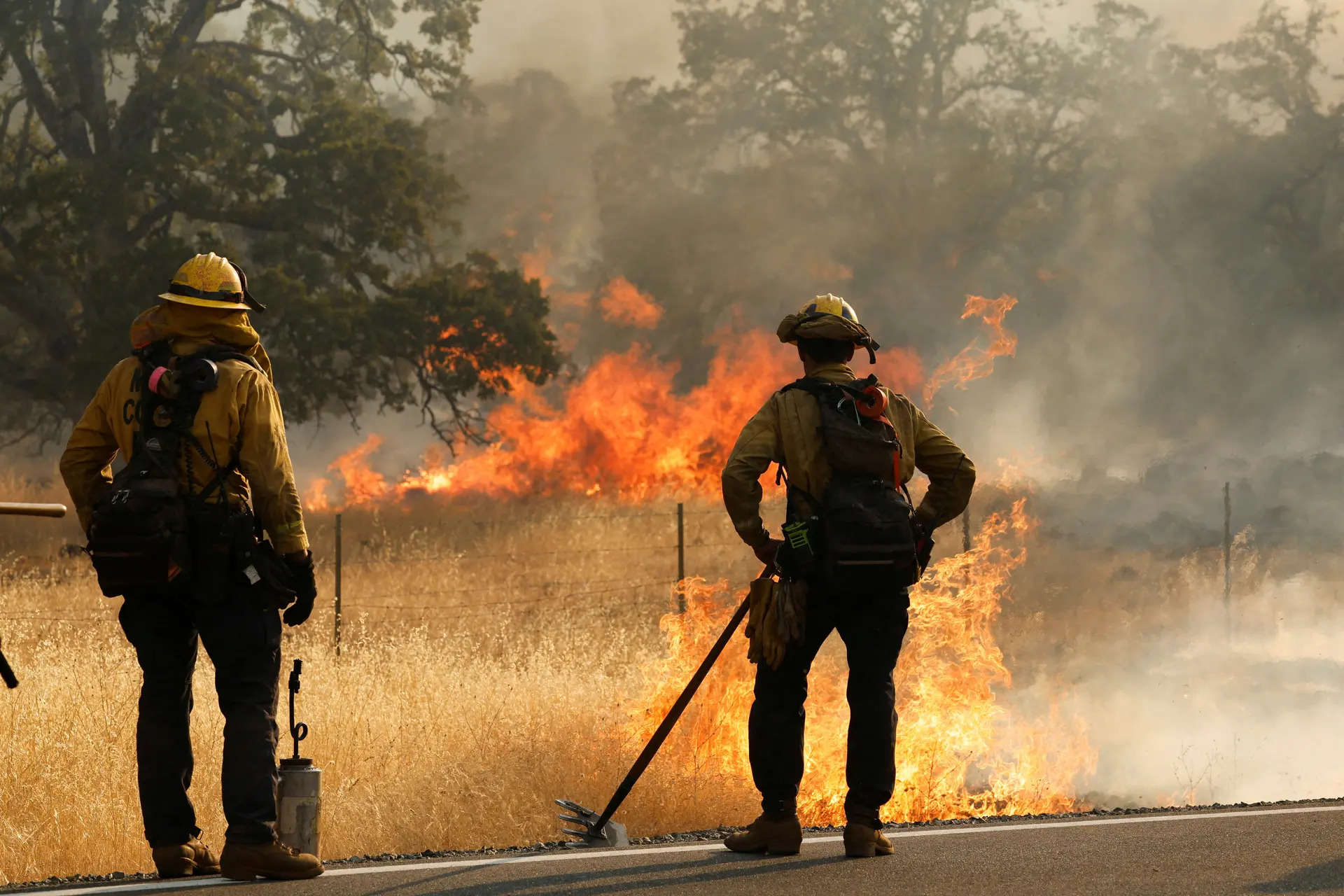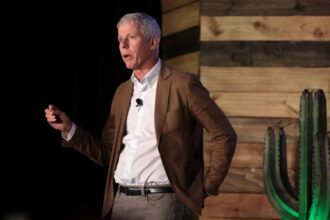California had all the ingredients for a terrible fire year. All it needed was a spark, or — authorities say — a single burning car.
The Park Fire raging out of control in the Sierra Nevada foothills may have started with an act of arson, after a man now in jail allegedly pushed a flaming car into a ravine. But it was able to outrun fire crews and explode in size — becoming California’s sixth-biggest fire on record — due to conditions that had been building for years.And those conditions could bode ill for the coming months.
Two wet winters in a row covered the state in newly-grown grass and brush. Then summer arrived with dry air and back-to-back heat waves, turning vegetation to fuel. “That made prime conditions for fire,” said Brent Pascua, a battalion chief with the California Department of Forestry and Fire Protection, or Cal Fire. “The fuel is still there, and the weather is too.”
Firefighters caught a brief break Monday, with high temperatures near the Park Fire expected in the low 90s. But triple digits are forecast to return by Thursday, according to the National Weather Service. More ominously, much of the US West, including a large part of California’s Sierra Nevada mountains, is forecast to be excessively hot from August 6 to August 8, according to the US Climate Prediction Center.
The combination of high heat and dry vegetation is not confined to California. Oregon has seen its share of flames, and last week a fast-moving blaze ripped through Jasper, Alberta, in one of Canada’s most pristine national parks, destroying a large part of the town. Smoke from all the fires has risen high into the atmosphere and spread across the continent. Outside Florida and the Gulf of Mexico coast, few spots in the US are smoke-free right now, said Andrew Orrison, a forecaster at the US Weather Prediction Center.
As it often does this time of year, high pressure has built up across the West, he said, raising temperatures and drying out the landscape. Although the annual Southwest monsoon has spun up thunderstorms, some have produced little rain, even as lightning strikes the ground — sparking more fires.
So far, flames have scorched more than 726,000 acres across California this year, according to Cal Fire, well above the five-year average of 123,388 acres by this point of the summer. In a sense, the state is feeling the backlash from a relatively quiet fire season last year. Record mountain snows blanketed the higher elevations well into the summer of 2023, and relatively mild temperatures slowed the drying of grasses. Much of what grew last year is still there, waiting to burn.
“There is all that biomass – fine, dry fuel – just ready to catch fire,” said Denise Knapp, conservation and research director at the Santa Barbara Botanic Garden.
The Park Fire began July 24 and has now burned more than 370,000 acres, according to Cal Fire. Authorities arrested Ronnie Dean Stout II, 42, of Chico, California, after witnesses saw a man push a burning car down a 60-foot embankment, with flames spreading into the grass. The area that is now burning, including parts of Lassen National Forest, is full of steep slopes and canyons, allowing the fire to spread quickly. The blaze was only 12% contained Monday.
The fire followed weeks of heat that sucked moisture from grasses and shrubs, with little relief even at night. “This 1-2 punch — i.e. the extra fuel for the fire from two years of robust growing conditions immediately followed by one of the hottest (if not the hottest) summer period on record — led to vegetation that approached or even exceeded record dryness levels, especially at lower elevations where the fire started,’’ said Daniel Swain, a climatologist at the University of California Los Angeles, in an email.
Decades ago, California’s fire season was thought to be tied to the arrival of Santa Ana and Sundowner winds in late summer or early fall. But in recent years, fires have broken out in months once thought safe, particularly during droughts. Many counties across northern and eastern California have become abnormally dry in recent weeks, a stage just below drought status, according to the US Drought Monitor. As of July 23, a little more than 21% of the state was abnormally dry or in drought. Wildfires will remain a threat until the rains return.
“In California it is a fire year,” Pascua said. “We have to come to terms with that.”
The Park Fire raging out of control in the Sierra Nevada foothills may have started with an act of arson, after a man now in jail allegedly pushed a flaming car into a ravine. But it was able to outrun fire crews and explode in size — becoming California’s sixth-biggest fire on record — due to conditions that had been building for years.And those conditions could bode ill for the coming months.
Two wet winters in a row covered the state in newly-grown grass and brush. Then summer arrived with dry air and back-to-back heat waves, turning vegetation to fuel. “That made prime conditions for fire,” said Brent Pascua, a battalion chief with the California Department of Forestry and Fire Protection, or Cal Fire. “The fuel is still there, and the weather is too.”
Firefighters caught a brief break Monday, with high temperatures near the Park Fire expected in the low 90s. But triple digits are forecast to return by Thursday, according to the National Weather Service. More ominously, much of the US West, including a large part of California’s Sierra Nevada mountains, is forecast to be excessively hot from August 6 to August 8, according to the US Climate Prediction Center.
The combination of high heat and dry vegetation is not confined to California. Oregon has seen its share of flames, and last week a fast-moving blaze ripped through Jasper, Alberta, in one of Canada’s most pristine national parks, destroying a large part of the town. Smoke from all the fires has risen high into the atmosphere and spread across the continent. Outside Florida and the Gulf of Mexico coast, few spots in the US are smoke-free right now, said Andrew Orrison, a forecaster at the US Weather Prediction Center.
As it often does this time of year, high pressure has built up across the West, he said, raising temperatures and drying out the landscape. Although the annual Southwest monsoon has spun up thunderstorms, some have produced little rain, even as lightning strikes the ground — sparking more fires.
So far, flames have scorched more than 726,000 acres across California this year, according to Cal Fire, well above the five-year average of 123,388 acres by this point of the summer. In a sense, the state is feeling the backlash from a relatively quiet fire season last year. Record mountain snows blanketed the higher elevations well into the summer of 2023, and relatively mild temperatures slowed the drying of grasses. Much of what grew last year is still there, waiting to burn.
“There is all that biomass – fine, dry fuel – just ready to catch fire,” said Denise Knapp, conservation and research director at the Santa Barbara Botanic Garden.
The Park Fire began July 24 and has now burned more than 370,000 acres, according to Cal Fire. Authorities arrested Ronnie Dean Stout II, 42, of Chico, California, after witnesses saw a man push a burning car down a 60-foot embankment, with flames spreading into the grass. The area that is now burning, including parts of Lassen National Forest, is full of steep slopes and canyons, allowing the fire to spread quickly. The blaze was only 12% contained Monday.
The fire followed weeks of heat that sucked moisture from grasses and shrubs, with little relief even at night. “This 1-2 punch — i.e. the extra fuel for the fire from two years of robust growing conditions immediately followed by one of the hottest (if not the hottest) summer period on record — led to vegetation that approached or even exceeded record dryness levels, especially at lower elevations where the fire started,’’ said Daniel Swain, a climatologist at the University of California Los Angeles, in an email.
Decades ago, California’s fire season was thought to be tied to the arrival of Santa Ana and Sundowner winds in late summer or early fall. But in recent years, fires have broken out in months once thought safe, particularly during droughts. Many counties across northern and eastern California have become abnormally dry in recent weeks, a stage just below drought status, according to the US Drought Monitor. As of July 23, a little more than 21% of the state was abnormally dry or in drought. Wildfires will remain a threat until the rains return.
“In California it is a fire year,” Pascua said. “We have to come to terms with that.”
Source : Times of India






